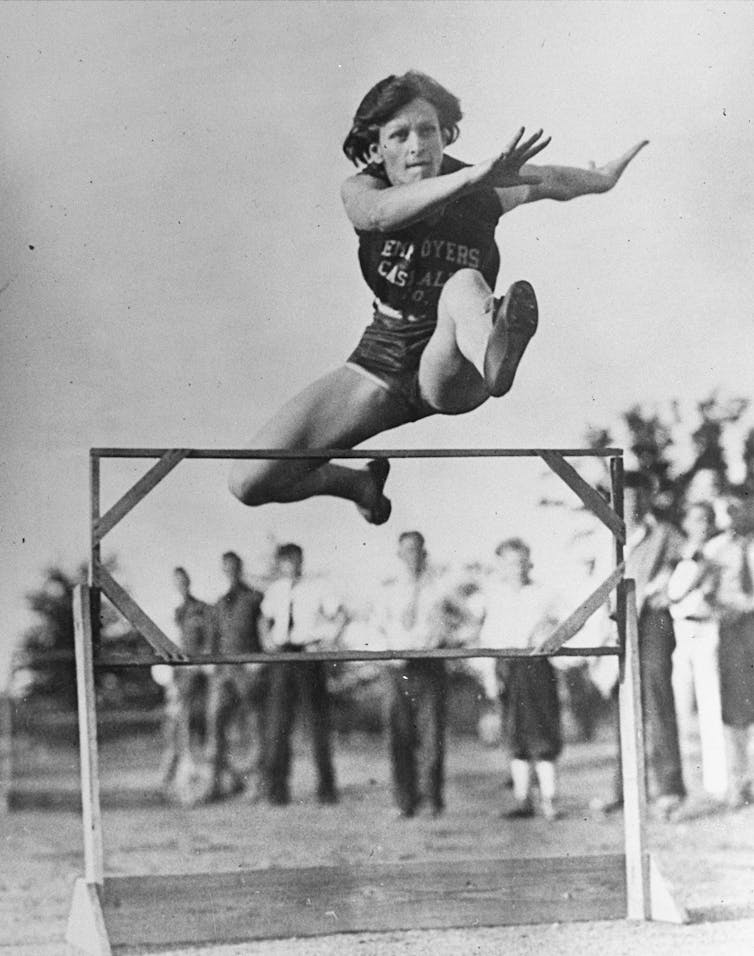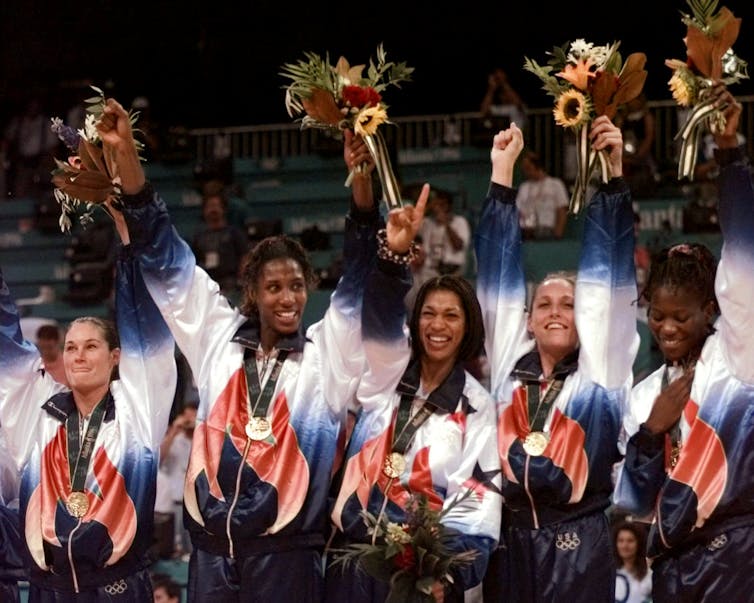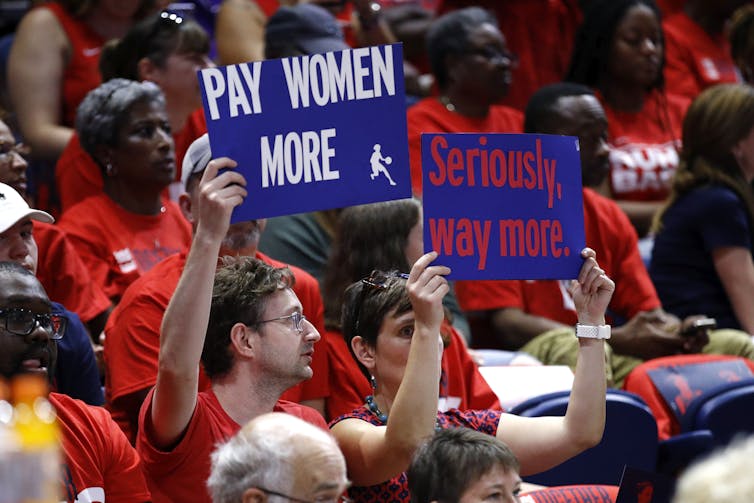Girls are reaching new heights in basketball, but huge pay gaps await them as professionals
- Written by Corinne M. Daprano, Associate Professor of Health & Sport Science; Interim Dean of the School of Education and Health Sciences, University of Dayton
Women have made great strides in the world of sports over the past 50 years.
Especially in some individual sports, female champion athletes today earn far more money and command a much bigger audience than their predecessors – thanks to breakthroughs by tennis champions like Billie Jean King and Venus and Serena Williams[1] and top golfers such as Kathy Whitworth, Nancy Lopez and Michele Wie[2].
We are fans of women’s basketball and scholars who study the role that gender plays in sports[3] and the changing status of female athletes[4]. Despite massive changes in attitudes toward women who excel at sports overall, with few exceptions we’ve observed that the disparity between what adolescent boys and girls[5] can aspire to accomplish in professional basketball today remains enormous.
This gap has become more visible due to the deaths of retired basketball legend Kobe Bryant[6], his daughter Gianna[7] and two of the other girls[8] on the basketball team he coached[9] in January.
Known as “Gigi,” the 13-year-old by all accounts inherited not only her former NBA player father’s love of the game, but silky smooth moves as well. She aspired to attend the University of Connecticut[10] where she would play on its highly ranked women’s basketball team[11]. Mourners spoke reverently about Gigi’s intentions to play professionally[12] and carry on her father’s legacy during a star-studded memorial service[13] for both of them held on Feb. 24.
Gigi Bryant, here wearing a No. 2 jersey on the Mamba team, was already a youth basketball star before her death at age 13.Fears about fertility
Women began playing basketball[14] in 1892, one year after the sport’s emergence.
Women’s basketball started as a passing game with its own peculiar rules. The court was divided into three sections and each team fielded nine players, versus the five who play on the court today. Players could not move out of their assigned area, were restricted to three dribbles, and could only hold the ball for three seconds. Players were also generally advised against engaging in strenuous activity as the medical experts at the time were convinced that overexertion would damage women’s fertility[15].
In 1896 teams from Stanford and the University of California, Berkeley competed in the first women’s intercollegiate basketball game[16]. Women kept playing basketball despite the perceived health risks.
 After Babe Didrikson won three Olympic medals in 1932, she excelled at other sports, including basketball and golf.
AP Photo[17]
After Babe Didrikson won three Olympic medals in 1932, she excelled at other sports, including basketball and golf.
AP Photo[17]
One of the most famous women’s amateur basketball teams of the 1930s was the Golden Cyclones[18] of the Employers Casualty Company of Dallas, which was led by track and field Olympic gold medalist and champion golfer Mildred “Babe” Didrikson Zaharias[19]. The first professional women’s basketball team was created in 1936. The All-American Red Heads[20] barnstormed the country[21] for more than 50 years.
Although the players were required to wear makeup and either dye their hair red or wear red wigs, the team played by men’s basketball rules against men’s teams. Despite the popularity of individual teams like the All-American Red Heads, women’s professional basketball struggled to gain a firm footing for decades.
Likewise, basketball did not become an Olympic sport for women until the 1976 Montreal Summer Olympic Games, four decades after men’s basketball made its debut at the 1936 Berlin Summer Olympic Games[22].
By that time, rules for women had become about the same as for men[23].
Kobe Bryant and his daughter Gigi believed that she would achieve great things as a basketball player.Title IX’s repercussions
The advent of a new federal civil rights policy enacted in 1972 changed the world of women’s sports. What became known as Title IX[24] was originally intended to provide equal opportunities and access for women in fields such as science, medicine and law.
In practice, Title IX forced high schools and colleges to open up more opportunities for female athletes[25] and to spend more money[26] and attention on girls’ and women’s sports teams.
But it would take more than 20 years for the emergence of a women’s professional basketball league.
A breakthrough in 1996
Sports fans dubbed the 1996 Summer Olympic Games the “Summer of the Women[27]” because U.S. women’s teams won gold[28] medals in softball, soccer, basketball and gymnastics[29].
The women’s Olympic basketball team’s success powered by star players Sheryl Swoopes[30], Rebecca Lobo[31] and Lisa Leslie[32] led to the creation of two women’s professional leagues.
The American Basketball League[33] proved short-lived, ceasing operations in 1998 after only three years. The Women’s National Basketball Association[34], known as the WNBA, is entering its 23rd season this summer.
 The victorious Olympic U.S. women’s team in 1996. Shown here, from left: Jennifer Azzi, Lisa Leslie, Carla McGhee, Katy Steding and Sheryl Swoopes.
AP Photo/Susan Ragan[35]
The victorious Olympic U.S. women’s team in 1996. Shown here, from left: Jennifer Azzi, Lisa Leslie, Carla McGhee, Katy Steding and Sheryl Swoopes.
AP Photo/Susan Ragan[35]
The WNBA and pay
Despite the WNBA’s staying power, its players until now have only earned an average salary of US$71,000[36], little more than 1% of the $6.4 million their typical male counterparts on NBA teams take home.
Average pay for WNBA players, however, will soon nearly double to about $130,000 a year, and some of the league’s star players will be making $500,000, following a collective bargaining agreement[37]. Players will now be eligible for maternity leave at their full salary, and can become unrestricted free agents after five full seasons.
Attendance at WNBA games now averages about 7,000 per game, compared to 18,000 at NBA games. The disparity in terms of the sports finances through TV deals and licensing agreements is much larger than that. The women’s league generates about $60 million in revenue, just a tiny fraction of 1% of the NBA’s $7.4 billion revenue.
 Many WNBA fans want the players to get big raises.
AP Photo/Patrick Semansky[38]
Many WNBA fans want the players to get big raises.
AP Photo/Patrick Semansky[38]
What will it take to bridge the huge gender gap in professional basketball’s popularity and pay?
We think that it could take a player like dunking sensation Stanford freshman Fran Belibi[39] who has captured significant media attention. Sabrina Ionescu[40], senior point guard for the Oregon Ducks, is another potential gamechanger.
Ionescu was named national player of the year[41] in 2019 as a junior. She has broken the National Collegiate Athletic Association’s triple-double[42] record for college women and men[43]. Ionescu had trained with her close friend and mentor, Kobe Bryant[44]. And Golden State Warriors star player Stephen Curry[45] has brought his daughters along to watch her play.
Or maybe it will take parents like Kobe Bryant and Curry, born after Title IX changed so much about athletics, to instill in their daughters an understanding that a sports career is not only feasible for women, but within reach.
[Get the best of The Conversation, every weekend. Sign up for our weekly newsletter[46].]
References
- ^ Billie Jean King and Venus and Serena Williams (www.cnbc.com)
- ^ Kathy Whitworth, Nancy Lopez and Michele Wie (golfcollege.edu)
- ^ role that gender plays in sports (scholar.google.com)
- ^ the changing status of female athletes (ecommons.udayton.edu)
- ^ disparity between what adolescent boys and girls (sociology.iresearchnet.com)
- ^ Kobe Bryant (theconversation.com)
- ^ daughter Gianna (www.youtube.com)
- ^ two of the other girls (www.khou.com)
- ^ basketball team he coached (www.cbsnews.com)
- ^ University of Connecticut (theundefeated.com)
- ^ highly ranked women’s basketball team (www.si.com)
- ^ intentions to play professionally (www.sbnation.com)
- ^ star-studded memorial service (sports.yahoo.com)
- ^ Women began playing basketball (www.timetoast.com)
- ^ overexertion would damage women’s fertility (www.jstor.org)
- ^ first women’s intercollegiate basketball game (125.stanford.edu)
- ^ AP Photo (www.apimages.com)
- ^ Golden Cyclones (flashbackdallas.com)
- ^ Mildred “Babe” Didrikson Zaharias (www.biography.com)
- ^ All-American Red Heads (www.hoophall.com)
- ^ barnstormed the country (www.si.com)
- ^ 1936 Berlin Summer Olympic Games (www.olympic.org)
- ^ the same as for men (fs.ncaa.org)
- ^ Title IX (titleix.harvard.edu)
- ^ opportunities for female athletes (www.womenssportsfoundation.org)
- ^ spend more money (apnews.com)
- ^ Summer of the Women (www.si.com)
- ^ women’s teams won gold (www.espn.com)
- ^ gymnastics (www.history.com)
- ^ Sheryl Swoopes (www.britannica.com)
- ^ Rebecca Lobo (espnpressroom.com)
- ^ Lisa Leslie (www.wnba.com)
- ^ American Basketball League (apnews.com)
- ^ Women’s National Basketball Association (www.womenshistory.org)
- ^ AP Photo/Susan Ragan (www.apimages.com)
- ^ average salary of US$71,000 (www.wsn.com)
- ^ collective bargaining agreement (www.wnba.com)
- ^ AP Photo/Patrick Semansky (www.apimages.com)
- ^ Fran Belibi (www.usab.com)
- ^ Sabrina Ionescu (sports.yahoo.com)
- ^ national player of the year (www.kptv.com)
- ^ triple-double (www.sportslingo.com)
- ^ record for college women and men (www.espn.com)
- ^ close friend and mentor, Kobe Bryant (www.theplayerstribune.com)
- ^ Stephen Curry (www.espn.com)
- ^ Sign up for our weekly newsletter (theconversation.com)
Authors: Corinne M. Daprano, Associate Professor of Health & Sport Science; Interim Dean of the School of Education and Health Sciences, University of Dayton

